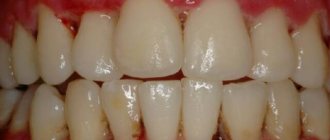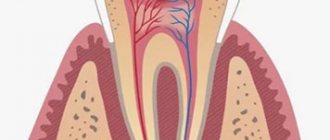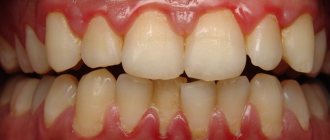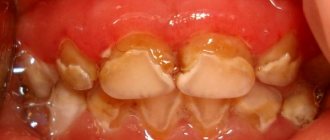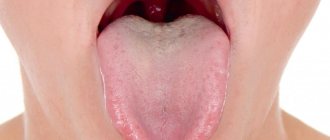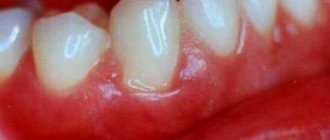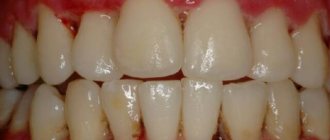Treatment and prevention of gingivitis at home should be of high quality and effective. If a patient neglects hygiene procedures, eats poorly, smokes, and does not treat caries and other dental diseases in a timely manner, the person will constantly experience inflammatory processes in the mouth, and the stages of remission will not last long.
The disease is divided into several types, which are accompanied by certain symptoms. Therapeutic regimens also differ, having their own characteristics depending on the type of disease. If a small child or a pregnant woman gets sick, it is important to adhere to some rules and exceptions in order not to harm the vulnerable body.
What is gingivitis
This is an acute or chronic inflammation of the gums in areas adjacent to the teeth. It occurs quite often in both adults and young patients. This problem also affects pregnant women in different trimesters. Babies during the teething period, as well as teenagers, are most susceptible to pathology. The disease occurs when the immune system is weakened, poor hygiene, or systemic illnesses.
The inflammatory process proceeds quite slowly. However, it is not difficult to detect it by its characteristic symptoms. If you do not consult a dentist in a timely manner, serious complications arise that are rarely treatable.
There are several successive stages of inflammation: mild, moderate, severe. At first, only the interdental spaces are affected, then the lesion spreads further. Then the lesion covers all mucous membranes in the oral cavity.
Prevention of gingivitis
Gingivitis is easier to prevent than to treat. To do this you need to follow these rules:
- Brush your teeth thoroughly twice a day. Rinse your mouth after every meal.
- Try not to eat a lot of sweets, especially sugary drinks. Eating more fresh, solid vegetables and fruits strengthens the body and helps remove plaque.
- Visit your dentist once or twice a year for an examination and professional cleaning. It will remove plaque and be able to recognize gingivitis at an early stage.
- Treat all serious diseases of the body in a timely manner.
- Avoid excessive stress.
- Consult a doctor immediately if installed braces, fillings or dentures constantly injure your gums.
These measures will help you avoid gum disease and keep your mouth healthy.
Causes of gingivitis
The main factor that contributes to the development of the disease is considered to be non-compliance with basic hygiene rules. When a person neglects daily cleanings and other maintenance procedures, the likelihood of ending up in the dental office with excruciating pain, bleeding, loose incisors, canines and molars, and other problems increases significantly.
Conventionally, all prerequisites for the appearance of pathology can be divided into internal and external. The first group includes:
- Growth of molars. Sometimes during this process soft tissue is injured, resulting in bleeding.
- Deficiency of vitamins and minerals in the body. The patient's immunity decreases and he is unable to resist pathological agents.
- Diseases of the gastrointestinal tract.
- Infections. This usually happens when preschool children have insufficient immune protection.
- Presence of carious lesions. They must be eliminated in time; caries must not be allowed to progress, otherwise complications will arise (periodontitis, loss of units, etc.).
External reasons:
- traumatic impact;
- burns of the mucous membranes of the mouth;
- irradiation;
- entry of heavy metals (lead, bismuth) into the patient’s body.
The problem is often diagnosed in pregnant women. This is due to hormonal and other changes. The same goes for teenage children.
Treatment of hypertrophic gingivitis
The principle and procedure for carrying out treatment procedures is similar to those for catarrhal gingivitis. However, the hypertrophic form sometimes requires surgical intervention.
Gingivectomy is a procedure performed to remove diseased tissue. Its stages can be seen in the figure below. Gingivectomy allows you to get rid of a large amount of excess tissue and prevent the accumulation of plaque, as well as stop the intensification of the inflammatory process.
Stages of gingivectomy
Types and symptoms of gingivitis
The types and symptoms of the pathological process are presented in the table:
| Type of pathology | Characteristic signs |
| Atrophic |
|
| Catarrhal |
|
| Hypertrophic |
|
| Ulcerative-necrotic |
|
Vincent's ulcerative-necrotizing gingivitis -
This type of gingivitis is officially called “Vincent ulcerative-necrotizing gingivitis.” Sometimes the terms Vincent's gingivitis or ulcerative gingivitis are used. This is the most severe form of gingivitis, which is accompanied by symptoms of intoxication of the body. There are acute and chronic forms of this disease (Fig. 12-15).
Causes of occurrence: critically poor oral hygiene plays a significant role in the development, when there is a significant increase in the mass of microbial plaque on the teeth (especially fusobacteria and spirochetes). Under these conditions, the local immunity of the oral mucosa is no longer able to cope with large amounts of toxins released by pathogenic bacteria. As a result, foci of mucosal necrosis and ulceration occur.
The triggering factor that initiates the development of necrotizing ulcerative gingivitis against the background of poor oral hygiene can be a sharp decrease in immunity or an exacerbation of severe concomitant chronic diseases of the body. But these factors are only predisposing; the main reason is poor hygiene and the accumulation of microbial plaque and/or tartar.
Acute ulcerative-necrotizing gingivitis: photo
Chronic ulcerative-necrotizing gingivitis: photo
Necrotizing ulcerative gingivitis: symptoms and treatment in adults, upon visual examination, you can find that the gums are covered with a whitish or yellowish coating, there are areas of gum ulceration, and some of the gingival papillae are necrotic. In the acute course of the disease, patients complain of high fever, loss of appetite, headaches, putrid breath, bleeding and pain in the gums (Fig. 12-13). In the chronic course of Vincent's gingivitis, the symptoms are less pronounced (Fig. 14-15).
How to cure ulcerative necrotizing gingivitis - treatment is carried out exclusively by a dentist, and urgently. The basis of treatment is the removal of dental plaque, including mandatory scraping of necrotic plaque. Plaque along with dental deposits can be easily removed using a conventional ultrasonic tip (scaler), followed by removal of plaque residues with a curettage spoon. Next, antibiotics, antiseptic rinses, and anti-inflammatory drugs are prescribed.
- Antibiotic therapy - prescribed antibiotics must be effective against fusobacteria and spirochetes, therefore a combination drug of amoxicillin and clavulanic acid, Amoxiclav, is usually prescribed in a tablet.
(for adults - tablets of 500 mg amoxicillin + 125 mg clavulanic acid, which are used 3 times a day - during the first day of the disease, and 2 times a day for the next 6 days). In parallel with Amoxiclav, you need to take the antibiotic Trichopolum (Metronidazole) - 500 mg 3 times a day, for a total of 7 days. In parallel with this, you should use antiseptic rinses with a 0.2-0.25% chlorhexidine solution, as well as a gum gel, for example, Cholisal.
Important: the use of antibiotics and antiseptics for self-medication (without removing deposits and necrotic plaque) will lead to the transition of acute necrotizing gingivitis to a chronic form. As a result, you will get gradual increasing necrosis of the gums, exposure of the roots of the teeth, as well as constant intoxication of the body. Therefore, an urgent visit to the dentist and removal of dental plaque is mandatory! After inflammation subsides, agents are prescribed that accelerate the epithelization of the mucous membrane, for example, Solcoseryl Gel.
How to treat gingivitis depending on the type
Therapeutic tactics depend on the type of disease. However, there are general steps that every dentist follows when developing a treatment regimen.
- Assessing the degree of contamination of hard surfaces. To determine the amount of plaque and calculate hygienic indices, tinting compounds are used. Areas covered with deposits immediately change color, so the doctor can assess the extent of the damage.
- Teaching the patient special rules of care. A brush, paste and other products are selected individually. The person is also told about the role of proper nutrition in oral health. For example, if you refuse solid foods, the interdental spaces and enamel will be poorly cleaned of food debris and accumulated pathogenic microflora.
- Professional cleaning in a clinical setting. For this purpose, ultrasound is often used, followed by polishing of the cervical area.
- Treatment of affected tissues with medications. Physiotherapy and surgical methods are used according to indications.
- If there is a history of chronic systemic diseases, the patient is referred for additional studies, including blood and urine tests. Consultations with specialists of a narrow profile are shown.
Atrophic
Diagnosis and treatment of gingivitis in adults (photos of symptoms are presented below) in this case should be comprehensive and individual. If the problem is caused by a general systemic disease, all actions are aimed at combating it.
Measures are also being taken to restore and strengthen the immune system. All factors leading to soft tissue trauma are excluded. The doctor performs professional cleaning and prescribes products that accelerate regeneration. If necessary, existing dentures and orthodontic structures are adjusted.
The infection is cleared with antibiotics. The gums are treated with antiseptic solutions. Physiotherapy and massage are provided. In severe cases, surgical intervention (gingivoplasty) cannot be avoided.
Catarrhal
First of all, it is important to exclude local exposure, as a result of which the disease developed. Under anesthesia, tartar and other deposits are removed, caries is eliminated, and dental units are filled. According to indications, prosthetics and frenuloplasty are performed.
Therapy can be either local or general medication. Applications are applied, rinsing and treatment of damaged mucous membranes is carried out.
Effective methods for treating this type of dental gingivitis include folk recipes. For example, you can rinse your mouth with herbal decoctions and apply medicinal bandages. If there is no effect or the patient’s condition worsens, other medications are prescribed and additional procedures are prescribed.
Hypertrophic
The pathological process is treated according to the standard regimen. First, the plaque is cleaned off, then antiseptic treatment is performed, baths are made, and physiotherapeutic methods are applied.
If your health does not improve, you cannot do without sclerotherapy, when special solutions are injected into the gingival papillae and additionally hormone-containing ointments and creams are prescribed. Restorative measures, installation of prostheses and orthodontic devices may be required.
Ulcerative-necrotic
First of all, it is important to take measures to restore and strengthen the immune system. It is also necessary to get rid of the external manifestations of the disease. To do this, the doctor performs professional cleaning, removes dead tissue, and treats the resulting ulcers with antiseptics to prevent infection.
The patient should pay special attention to the hygiene of mucous membranes, constantly rinse the mouth, treat with gels, ointments and other local compounds.
A diet containing foods containing large amounts of protein and vitamins is indicated. Drinking should be plentiful.
Gingivitis: treatment at home
Once again, let us draw your attention to a very important point - treatment of gingivitis in adults at home is only possible in terms of a course of anti-inflammatory therapy. At home, you can successfully use antiseptic rinses and applications to treat catarrhal gingivitis, but to remove plaque, you still need to visit the dentist!
A small example: a person’s gums are bleeding and he decides to use the remedies he heard about in an advertisement. These can be various gels, rinses or anti-inflammatory toothpastes. And indeed, as long as a person uses such means, bleeding decreases or disappears completely for a while. But as soon as the use of the products is stopped, the gums begin to bleed again, plus their swelling and redness return.
The reason for this is quite commonplace - the person tried to treat the symptoms (such as bleeding, pain, swelling) without removing the cause of these symptoms (microbial plaque, as well as hard supra- and subgingival dental plaque). Advertisements for various dental products do not talk about the causes of bleeding or the need to remove dental plaque. Moreover, for obvious reasons... We hope that our article on the topic: Gingivitis symptoms and treatment in adults was useful to you!
Sources:
1. Dental education of the author of the article, 2. Based on personal experience as a periodontist, 3. National Library of Medicine (USA), 4. American Academy of Periodontology (USA), 5. “Non-surgical periodontal treatment” (Roncati M.).
How to cure gum gingivitis at home
It is worth treating at home only if the dentist has already examined the oral cavity, conducted the necessary diagnostic tests, studied the medical history and made recommendations that will help get rid of the unpleasant illness. Along with medications, the patient can use folk recipes that have been proven over the years. However, such drugs, despite their relative safety, can cause adverse reactions due to intolerance to the components and for other reasons. Therefore, the dentist must calculate the dosage himself and advise which herbal decoctions and solutions will not cause harm and are highly effective.
It is important to adhere to a special diet and include fruits and vegetables such as:
- citrus fruits (contain a lot of vitamin C, which helps strengthen vascular walls and prevent bleeding);
- apples, pears (include pectin, which accelerates the restoration of soft tissues);
- currants, raspberries and other berries (increase human immunity);
- zucchini, cabbage, carrots and other vegetables (accelerate metabolic and regeneration processes due to the fiber and antioxidants they contain).
You should exclude fast carbohydrates, baked goods, sweets, and potato dishes from the menu. They lead to the formation of thick plaque on the teeth, and subsequently - tartar.
Anti-gingivitis medications
In some cases, antibiotics cannot be avoided. However, all prescriptions should be made exclusively by the attending physician based on the clinical picture, the patient’s medical history, his well-being and other manifestations. Most often Amoxicillin, Metronidazole, and Erythromycin are used for these purposes.
Local agents
Gel and cream medications significantly alleviate the manifestations of the disease. These are anti-inflammatory compounds for external use such as Cholisal, Solcoseryl, Metrogyl Denta, Asepta and others.
Traditional methods
Some people, when the first symptoms of pathology appear, try to find information on the Internet and old books at home on how to treat gum gingivitis at home without pharmaceutical drugs. It should be remembered once and for all - no “grandmother’s” recipes, even if they show high effectiveness, should not be used without the approval of a doctor.
In combination with medications and other means, herbal medicine will help to significantly speed up recovery. Let's look at methods for preparing medicinal decoctions and solutions, often recommended by doctors.
- Pour 1 tbsp. l. sage with a glass of boiling water, leave for half an hour. When the composition has cooled to room temperature, it is necessary to strain it through cheesecloth or a sieve. Rinse every time after eating.
- Prepare an aqueous solution from 1 tsp. baking soda per glass of warm liquid. You need to rinse your mouth with this mixture to remove leftover food.
- Mix 2 tablespoons of crushed oak bark and dried celandine, pour boiling water (about 400 ml). It is necessary to rinse the mouth well 4 times a day until the unpleasant manifestations of the pathology completely disappear.
Vitamins
Taking vitamin and mineral supplements is an integral part of complex therapy. Doctors usually issue orders for the purchase of pharmaceutical products containing substances of groups C and P (Ascorbic acid, Ascorutin, etc.).
Treatment of ulcerative gingivitis
Therapeutic measures should be aimed at eliminating the inflammatory process, increasing the patient’s body’s resistance to microbes, and preventing the influence of local factors that provoke necrotizing ulcerative gingivitis. Let's consider the main stages and principles of the treatment.
- Professional oral hygiene.
- Antibacterial and anti-inflammatory therapy.
- One of the features of the treatment of necrotizing ulcerative gingivitis is the removal of necrotic areas of tissue; Hydrogen peroxide and chlorhexidine are usually used.
- The use of keratolytic agents, vitamins, adaptogens.
- Training in the rules of proper oral hygiene, as well as monitoring hygienic skills.
- One of the features of the ulcerative form of the disease is severe pain, therefore the treatment of gingivitis, due to the difficulty of carrying out normal hygienic care, is accompanied by the use of antiseptics and anti-plaque agents.
- Elimination of factors contributing to the formation of plaque on the surface of teeth.
- Elimination of the problem that aggravates the proliferation of microorganisms and their pathogenic effects.
Features of treatment of gingivitis
Some categories of patients require special treatment. The body of the child and the expectant mother, due to its characteristics, is more vulnerable than ever to external factors. However, many drugs and procedures that show effectiveness and speed up recovery are contraindicated. However, this does not mean that you need to abandon all intervention options, suffer with unpleasant symptoms and wait for the pathology to go away on its own.
Treatment in children
Therapeutic tactics in this case are practically no different from those in adult patients. However, there are still some features that are important to pay attention to.
- Ultrasound cleaning. The procedure does not cause pain or other unpleasant sensations and lasts no more than 20 minutes.
- Anti-inflammatory, antibacterial treatment. Gel-like compositions (Metrogil Denta, Cholisal) are applied to the mucous membranes; rinsing with Miramistin, Chlorhexidine, etc. is indicated.
- Strengthening the immune system. It is necessary to give vitamins, A and E are especially important, since they have a beneficial effect on the regeneration of soft tissues.
- Orthodontic intervention. Indicated for children with bite defects, which caused the pathological process.
When diagnosing an ulcerative-necrotic form, upon completion of the initial stage of therapy, dead fibers are removed under local anesthesia, and the mucous membranes are cauterized with electric current. Both before and after the procedure, doctors use light pain-relieving gels, for example, Kamistad, Kalgel.
Particular attention should be paid to the patient's hygiene. Without quality care, the pathology will not go away or will return again.
The disease in infants is treated differently. In such a case, regular massage and antimicrobial cleaning with a finger brush made of silicone are sufficient.
Treatment in pregnant women
How and with what to treat gingivitis in an adult at home, if this is a woman carrying a child? It should immediately be noted that the pathological process in expectant mothers occurs due to hormonal changes and a lack of nutrients in the body. For this reason, vitamin therapy is mandatory.
Antibiotics are contraindicated. The dentist removes accumulated dental plaque and recommends antiseptic medications that are safe for the fetus. Vacuum gum massage shows high efficiency.
You can rinse your mouth with a chamomile decoction at room temperature, this will help relieve swelling and get rid of bleeding. Medicines for oral administration should be prescribed exclusively by doctors; self-medication is unacceptable.
It is better to use brushes with soft bristles and avoid consuming hard products.
Catarrhal gingivitis: symptoms
Among all patients with gingivitis, this form accounts for more than 97% of cases. Those. This is the most common form of this disease. The term “catarrhal” means that the inflammation affects only the mucous membrane of the gums, i.e. flows superficially. Thus, with gingivitis, there is no destruction of the bone tissue around the teeth, as well as destruction of the periodontal attachment. In Fig. 3-5 you can see what catarrhal gingivitis looks like in the oral cavity.
The cause is exceptionally insufficient oral hygiene, as a result of which soft microbial plaque accumulates in the area of the necks of teeth, and the formation of tartar occurs. Plaque bacteria produce toxins and pathogens, which trigger inflammation in the gum mucosa. At the same time, various chronic diseases or vitamin C deficiency are not the direct causes of the development of gingivitis, but may be a predisposing factor that increases the impact of microbial plaque.
Catarrhal gingivitis: photo
Symptoms –
- swelling of the gingival margin and interdental papillae,
- redness or bluishness of the gums,
- bleeding gums when brushing teeth,
- pain when brushing teeth,
- itching in the gums,
- Usually, accumulations of microbial plaque are visible at the necks of teeth.
The appearance of bleeding is associated with an increase in the permeability of capillary walls, capillary fragility, as well as a decrease in the thickness of the epithelium of the gum mucosa. All this arises as a result of the influence of toxins and microbial plaque pathogens on the mucous membrane of the gums. Most often, bleeding occurs when the gums are exposed to mechanical factors (for example, when brushing teeth or chewing rough, hard food).
Pain when brushing teeth is also associated with thinning of the epithelium of the gum mucosa. Thinning of the epithelium against the background of gum inflammation is a natural process, and develops due to an increase in the rate of desquamation of epithelial cells (24stoma.ru).
Forms of catarrhal gingivitis –
There are 2 variants of the course of the catarrhal form of gingivitis. Firstly, there is acute catarrhal gingivitis (Fig. 3-4), which is characterized by bright red gum color, acute development, and sometimes significant bleeding and pain when brushing teeth. With this form of the disease (due to pain when brushing teeth), patients sometimes abandon oral hygiene altogether, which leads to an even greater increase in the amount of microbial plaque, and as a result, to an increase in gum inflammation.
Secondly, the chronic form of the disease (Fig. 5-6), which is characterized by sluggish symptoms over a long period of time. Chronic catarrhal gingivitis symptoms of bleeding will be quite minor, and pain during brushing may be completely absent. The marginal gum and periodontal papillae will have a bluish color. However, exacerbation of symptoms may periodically occur, which usually occurs against the background of a decrease in immunity during the period of colds.
Chronic catarrhal gingivitis –
Diagnostic features
Gingivitis can be recognized visually—sometimes one examination by a doctor is enough. But you should make sure that there are no more serious pathologies, so diagnosis may include not only a visual assessment of the condition of the oral cavity, but also other measures:
- collecting anamnesis, assessing the condition of structures in the oral cavity;
- probing of periodontal pockets if present;
- determination of tooth mobility;
- electroodontodiagnosis to determine the condition of the dental pulp;
- panoramic x-ray or targeted x-ray - to exclude periodontitis, periostitis and other pathologies of deep structures, jaw bone tissue, etc.
It is important to take into account the presence of chronic diseases and medications. Only with complete information can a doctor make an accurate diagnosis and develop an effective treatment regimen.
Etiology of catarrhal gingivitis
The causes of catarrhal gingivitis are represented by general and local factors. The latter are as follows:
- injuries to gums and teeth;
- dental anomalies (crowding, dystopia);
- severe teething;
- cervical caries;
- poor oral hygiene;
- incorrectly installed fillings, dentures, veneers, braces;
- abnormalities of the soft tissues of the oral cavity.
Common factors that can lead to the development of the disease are as follows:
- changes in hormonal levels due to pregnancy, menopause in women;
- gastrointestinal diseases;
- diabetes;
- blood diseases;
- thyroid diseases;
- viral infections;
- taking immunosuppressants and cytostatics.
In our clinic you can get a free dental consultation!
Diagnostic tests
- Schiller-Pisarev test
This test is based on determining the level of glycogen in the gum. Its amount increases significantly during inflammation, while healthy gums do not contain glycogen. Lubricating the inflamed gums with Schiller-Pisarev solution gives a color change reaction from light brown to brown. This research method is used to make diagnoses of both periodontitis and gingivitis.
- Assessment of oral hygiene level
A solution (2 g of potassium iodide, 1 g of crystalline iodine, 40 ml of distilled water) is applied to the outer surface of the six lower front teeth.
The assessment is carried out using a five-point system and each tooth is assessed separately:
- 5 points – complete staining of the entire tooth surface;
- 4 points – staining of ¾ of the tooth surface;
- 3 points – staining of half the tooth surface;
- 2 points - staining of a quarter of the tooth surface;
- 1 point - absence of any staining of the tooth surface.
Then the scores of all examined teeth are summed up and divided by their number (usually the test is carried out on six teeth). This is how the hygiene index is obtained.
As a result, the quality of hygiene is assessed:
- 1.1-1.5 points – good hygiene index;
- 1.6—2.0—satisfactory hygiene index;
- 2.1—2.5—unsatisfactory hygiene index;
- 2.6—3.4—poor hygiene index;
- 3.5-5.0 - very poor hygiene index.
- Vacuum test according to Kulazhenko
Using a Kulazhenko vacuum apparatus, it is possible to determine the time of hematoma formation when a vacuum is applied to the gum area. Typically, the test is carried out in the incisor area by placing a tube of the device on the gum. The formation of a hematoma in 60 seconds indicates the normal condition of the gums, while the appearance of a hematoma in 29-30 seconds signals an inflammatory process.
- Oxygen tension in gum tissue
The sensor of the device is applied to the gum, and the device records the level of tissue hypoxia. Reduced oxygen tension indicates a prolonged inflammatory process.
Ulcerative gingivitis – Prices
| Services | Price |
| Periodontist consultation | 1100 rub. |
| Consultation with a periodontist with drawing up a treatment plan | 1000 rub. |
| Medicinal treatment of periodontal pockets in the area of 2 teeth | 200 rub. |
| Surgical treatment of periodontal pocket 1 tooth | 600 rub. |
| Tooth extraction according to DS: Periodontitis, with bone grafting (preparation for implantation using biomaterials) | 20,000 rub. |
| Opening a periodontal abscess | 1750 rub. |
| Flap surgery on the periodontium of one jaw without the use of biomaterials | from 3000 rub. |
Treatment methods
Local treatment is usually sufficient to treat uncomplicated gingivitis; in severe cases, antibiotics and surgery may be necessary. Additionally, the doctor may recommend a diet to reduce the burden on inflamed gums and also support the immune system.
Cleaning teeth from stone and plaque, treating caries lesions are the first stages of therapy. Their goal is to eliminate the root cause, the source of infection. If the plaque is not removed, the treatment will be ineffective, and after a while the disease will recur.
Next, the doctor prescribes antimicrobial and restorative treatment. Depending on the stage of the disease, they may take 10-20 days.
The goal of local treatment is to quickly relieve symptoms, relieve pain and remove inflammation. For this purpose, rinsing solutions, herbal decoctions, ointments and gels are used.
It is important not to eat or drink for at least an hour after rinsing. It is also forbidden to swallow rinses - if they enter the stomach, they can cause inflammation of the mucous membrane and even severe poisoning.
Alcohol-based solutions should be used with caution: they can burn or dry out the mucous membrane, which will lead to even greater inflammation.
Ointments and gels are rubbed into the gums and left for a while. They provide a lasting disinfectant and anti-inflammatory effect and stimulate healing processes.
The effect of treatment is enhanced if you use anti-inflammatory toothpastes. But bleaching agents with abrasives should be avoided: they can damage already inflamed gums.
Prevention
To avoid disease, it is important, first of all, to adhere to hygiene rules: brush your teeth twice a day to remove bacterial plaque, choose the right toothbrush, rinse your mouth after eating, and visit the dentist’s office for preventive purposes. You also need:
- Eat right - include more vitamin-rich foods, fiber in your diet, limit sweets and fast carbohydrates;
- Treat infectious and inflammatory diseases of the oral cavity and caries in a timely manner;
- Periodically perform professional teeth cleaning and tartar removal;
- Strengthen immunity.
At the first signs of the development of an inflammatory process, you should consult a doctor to prevent inflammation from spreading deep into the gum tissue and developing complications.
Differential diagnosis of gingivitis
It is based on the complaints presented to the patient, a visual examination of the patient, the results of functional tests and laboratory tests. The goal of differential diagnosis is to distinguish gingivitis from other periodontal diseases, such as periodontitis and periodontal disease.
The main feature that distinguishes gingivitis from other periodontal diseases is that the inflammatory process affects only the gum tissue, the remaining structures (muscle ligaments that hold the tooth in the jaw and bone tissue) remain unchanged.
Along with this symptom, gingivitis is not characterized by periodontal pockets, exposure of the necks of teeth, or their mobility. And the x-ray shows no signs of bone resorption.
Identifying gingivitis in a timely manner, determining its form and prescribing the correct treatment is the task of a periodontist. But not to forget about prevention and regularly visit the dental clinic is the maximum program for the patient. This is the only way to avoid a more serious periodontal disease – periodontitis.
Gingivitis: my gums hurt
The process, which is characterized by gum inflammation, swelling, redness and bleeding, is called gingivitis and is one of the most common periodontal diseases in both children and adults. Only 3% of people can boast of absolutely healthy gums. How to get into such a small percentage of lucky ones? The answer is simple - follow the necessary measures to prevent gum inflammation, regularly visit the doctor and not let even seemingly harmless signs of an incipient disease take their course.
Gingivitis is the last of all diseases in periodontology in which the inflammatory process can still be stopped. Next comes periodontitis, a disease in which inflammation spreads to other periodontal tissues. From this point on, treatment is based only on bringing the disease into remission and attempts to relieve symptoms as much as possible at the time of relapses, as well as in the future when it is necessary to resort to tooth extraction. Therefore, gingivitis in children and adults requires increased attention in order to avoid serious periodontal problems.
